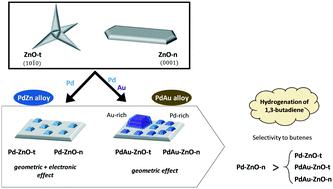当前位置:
X-MOL 学术
›
Catal. Sci. Technol.
›
论文详情
Our official English website, www.x-mol.net, welcomes your feedback! (Note: you will need to create a separate account there.)
Pd–Au bimetallic catalysts supported on ZnO for selective 1,3-butadiene hydrogenation
Catalysis Science & Technology ( IF 5 ) Pub Date : 2020-03-05 , DOI: 10.1039/c9cy02395j Belén Bachiller-Baeza 1, 2, 3, 4 , Ana Iglesias-Juez 1, 2, 3, 4 , Giovanni Agostini 5, 6, 7 , Eva Castillejos-López 4, 8, 9, 10, 11
Catalysis Science & Technology ( IF 5 ) Pub Date : 2020-03-05 , DOI: 10.1039/c9cy02395j Belén Bachiller-Baeza 1, 2, 3, 4 , Ana Iglesias-Juez 1, 2, 3, 4 , Giovanni Agostini 5, 6, 7 , Eva Castillejos-López 4, 8, 9, 10, 11
Affiliation

|
Bimetallic Pd–Au catalysts were synthesized using two differently shaped ZnO supports, ZnO-t (tetrapods) and ZnO-n (needles). These catalysts were tested in the partial hydrogenation of 1,3-butadiene and the results were compared to those for the corresponding monometallic catalysts of Pd. The structural and electronic properties of the catalysts were analysed by transmission electron microscopy and scanning transmission electron microscopy (TEM-STEM), Fourier transform infrared spectroscopy analysis of adsorbed CO (CO-FTIR), X-ray photoelectron spectroscopy (XPS) and in situ X-ray absorption spectroscopy (XAS) measurements combined with in situ diffuse reflectance infrared Fourier transform spectroscopy (DRIFTS). On both catalysts, gold diffusion on the Pd(111) faces and formation of small Pd-rich particles and big Au-rich core/Pd-rich shell like structures were confirmed. Besides, both Pd–Au bimetallic samples gave similar conversion and selectivity values in the hydrogenation reaction. The product distribution resembled that for monometalic Pd on ZnO-t, except for the selectivity to 1-butene among the butenes which was slightly higher. The best catalyst in terms of selectivity to the butenes is Pd–ZnO-n. The differences found in the catalytic performance were analysed based on electronic and ensemble effects. In contrast to that found for the monometallic catalysts, the support morphology does not seem to be a determinant for the properties in the case of the Pd–Au bimetallic samples.
中文翻译:

负载在ZnO上的Pd-Au双金属催化剂用于1,3-丁二烯选择性加氢
使用两种不同形状的ZnO载体ZnO-t(四脚架)和ZnO-n(针)合成了双金属Pd-Au催化剂。在1,3-丁二烯的部分加氢中测试了这些催化剂,并将结果与相应的Pd单金属催化剂进行了比较。通过透射电子显微镜和扫描透射电子显微镜(TEM-STEM),吸附CO的傅里叶变换红外光谱分析(CO-FTIR),X射线光电子能谱(XPS)和原位分析了催化剂的结构和电子性质。X射线吸收光谱(XAS)测量与原位结合漫反射红外傅里叶变换光谱(DRIFTS)。在这两种催化剂上,均证实了金在Pd(111)面上的扩散以及富Pd小颗粒和富Au核/富Pd壳状结构的形成。此外,两种钯金双金属样品在氢化反应中给出的转化率和选择性值均相似。产物分布类似于ZnO-t上单金属Pd的分布,只是丁烯中对1-丁烯的选择性略高。就对丁烯的选择性而言,最好的催化剂是Pd–ZnO-n。基于电子和整体效应分析了催化性能中的差异。与单金属催化剂相比,在Pd-Au双金属样品的情况下,载体的形貌似乎并不决定其性能。
更新日期:2020-03-05
中文翻译:

负载在ZnO上的Pd-Au双金属催化剂用于1,3-丁二烯选择性加氢
使用两种不同形状的ZnO载体ZnO-t(四脚架)和ZnO-n(针)合成了双金属Pd-Au催化剂。在1,3-丁二烯的部分加氢中测试了这些催化剂,并将结果与相应的Pd单金属催化剂进行了比较。通过透射电子显微镜和扫描透射电子显微镜(TEM-STEM),吸附CO的傅里叶变换红外光谱分析(CO-FTIR),X射线光电子能谱(XPS)和原位分析了催化剂的结构和电子性质。X射线吸收光谱(XAS)测量与原位结合漫反射红外傅里叶变换光谱(DRIFTS)。在这两种催化剂上,均证实了金在Pd(111)面上的扩散以及富Pd小颗粒和富Au核/富Pd壳状结构的形成。此外,两种钯金双金属样品在氢化反应中给出的转化率和选择性值均相似。产物分布类似于ZnO-t上单金属Pd的分布,只是丁烯中对1-丁烯的选择性略高。就对丁烯的选择性而言,最好的催化剂是Pd–ZnO-n。基于电子和整体效应分析了催化性能中的差异。与单金属催化剂相比,在Pd-Au双金属样品的情况下,载体的形貌似乎并不决定其性能。


























 京公网安备 11010802027423号
京公网安备 11010802027423号